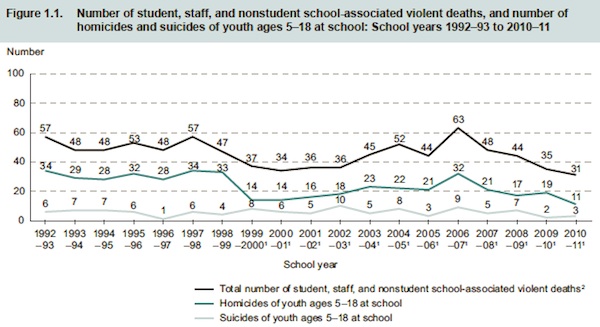Following up on my American Spectator piece, based on my article The Shooting Cycle, comes a new report from the Bureau of Justice Statistics on school safety. This report offers the most recent breakdown of numbers, through 2011, of school shootings. And, it is largely in keeping with earlier research–these tragedies are rare, and are not happening more frequently. Reason has a thorough break-down of the data.
The report compiled the total number of homicides “at school,” defined to include deaths both inside and off campus, “while the victim was on the way to or from regular sessions at school or while the victim was attending or traveling to or from an official school-sponsored event.” This is a much broader of definition than would likely be considered in the common parlance of what constitutes a school shooting. The report found that there were “31 school-associated violent deaths from July 1, 2010, through June 30, 2011,” consisting of “25 homicides and 6 suicides.” Through 2011, the number of school homicides is falling.
Factoring in the shooting at Sandy Hook in 2012–deaths of 20 children and 6 adults–would result in a spike to the trend. Preliminary data suggests that there “17 school-associated violent deaths between December 15, 2012, and November 14, 2013,” which would be closer to the average.
The data also offers some interesting data about the relative safety of schools. The BJS found that ”During the 2010–11 school year, 11 of the 1,336 homicides among school-age youth ages 5–18 occurred at school.” Further, “all available survey years, the percentage of youth homicides occurring at school remained at less than 2 percent of the total number of youth homicides, and the percentage of youth suicides occurring at school remained at less than 1 percent of the total number of youth suicides.” During the 2010-2011 school year, “was approximately 1 homicide or suicide for each 3.5 million students enrolled.” The report concluded, “Violent deaths at schools are rare but tragic events with far-reaching effects on the school population and surrounding community.”
The BJS report shows similar trends for college campuses. “Fifteen murders occurred on college campuses in 2011, the same number as in 2010,” and on the whole, “the number of on-campus crimes reported in 2011 was lower than in 2001 for every category, except for forcible sex offenses.”
The importance of accurate statistics is essential to meaningfully address reforms. As the BJS report notes, “it is difficult to gauge the scope of crime and violence in schools given the large amount of attention devoted to isolated incidents of extreme school violence. Measuring progress toward safer schools requires establishing good indicators of the current state of school crime and safety across the nation and regularly updating and monitoring these indicators.” Misinformation only clouds the debate, and frustrates efforts to tackle the problems.
The gun-control group, Everytown for Gun Safety, funded largely by former-New York City Mayor, compiled a list in June 2014 showing 74 school shootings since Sandy Hook. Thirty-five of these incidents occurred on, or near a college campus. Several are nonfatal, including “including accidental discharges and at least four events in which no one was injured at all.” Charles Johnson found that many of the so-called shootings were not at all school-related (you can click through the various news reports).
